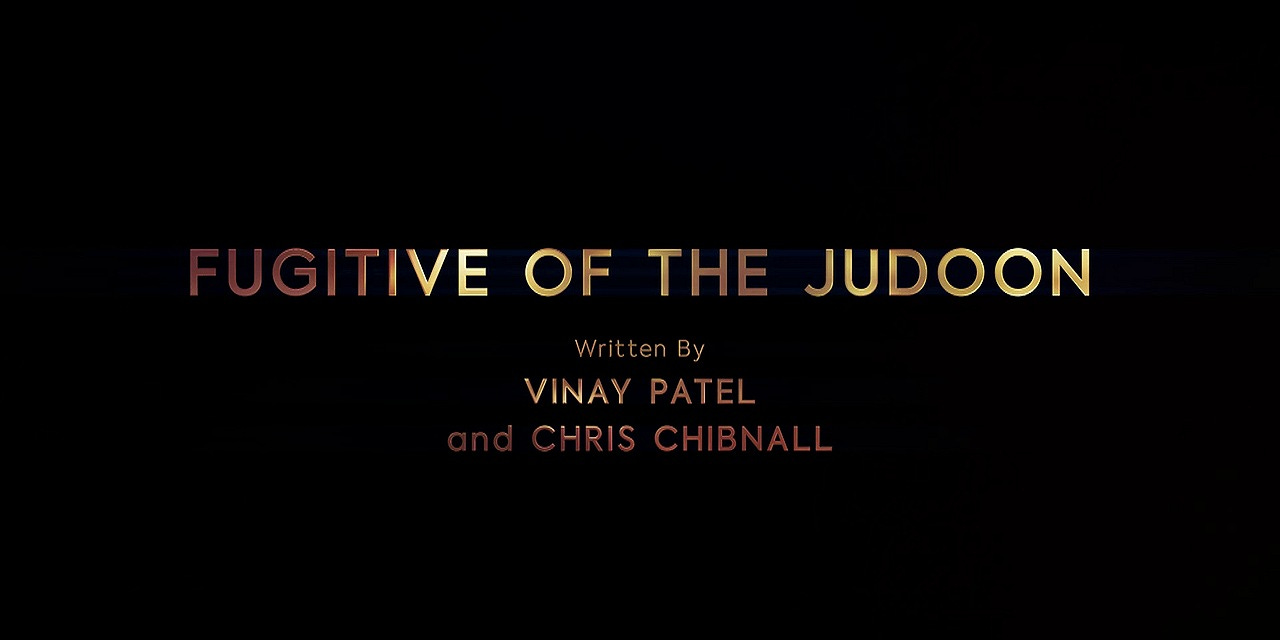
Doctor Who
“Fugitive of the Judoon”
Series 12, Episode 5
Written by Vinay Patel and Chris Chibnall
Directed by Nida Manzoor
Starring Jodie Whittaker, Tosin Cole, Mandip Gill, and Bradley Walsh
Guest Starring Jo Martin, Ritu Arya, John Barrowman, Judith Scott, and Neil Stuke
50 minutes
Original broadcast 26 January 2020
1. The Summit?
Every now and then, Doctor Who offers up an installment so remarkable in its implications, construction, and execution that, as fans and as critics, we can only marvel at the result.
Such an outing is “Fugitive of the Judoon.”
Series 11 gave us one of these all-time classics in its third episode, “Rosa,” by bringing Rosa Parks to sensational and vibrant life. Then Series 11’s sixth entry, “Demons of the Punjab,” emerged as a terrific story that we may revisit again and again, never tiring of its presence or its wonders.
Plus, so fine are Series 1’s “Dalek” and “The Parting of the Ways,” Series 2’s two-part “The Impossible Planet” / “The Satan Pit,” Series 3’s brilliant one-off entry “Blink” and its two-part stunner “Human Nature” / “The Family of Blood,” Series 4’s “Midnight,” 2013’s “The Day of the Doctor” (aka the Fiftieth Anniversary Special), and Series 9’s “Heaven Sent” that they (to name only a few) become lodestars, even supernovae, in the New Who firmament.
Series 12, not to be outdone, smashed this record by introducing Chris Chibnall’s version of the Master, wonderfully played by Sacha Dhawan, in the final moments of its premiere episode (“Spyfall: Part One”) to thrill and chill longtime viewers by resurrecting a malevolent character supposedly killed for good in Series 10’s “The Doctor Falls” (itself an excellent entry).
So, when “Fugitive of the Judoon” returns to our screens the rhinoceros-like, interstellar mercenary police force introduced by Russell T. Davies in Series 3’s premiere episode (“Smith and Jones”), we may think that seeing them again after so prolonged an absence is enough (the Judoon, lest we forget, last appeared via short cameo in Series 9’s “Face the Raven” way back in 2015). And, for any normal installment, seeing the Judoon (in all their foot-stomping glory) would be enough.
Yet “Fugitive of the Judoon” isn’t content to wow us by bringing back one of New Who’s most fondly remembered extraterrestrial species. No, this outing gives us another, even more unexpected arrival alongside a revelation so astounding in its power that, by episode’s end, we can only bask in the glorious leavings of perhaps the best meal the Chibnall era has yet provided us.
Or, at least, that was my response upon watching “Fugitive of the Judoon” during its inaugural broadcast. Revisiting this entry only confirms these impressions as accurate, since “Fugitive of the Judoon” scales the summit of New Who’s highest achievements. Yes, dear reader, “Fugitive of the Judoon” really is that good.
Although more-recent converts to Doctor Who may not fully understand all the callbacks, references, and Easter eggs that writers Vinay Patel and Chris Chibnall braid into this outing’s narrative tapestry, old timers may well scream with delight as “Fugitive of the Judoon” inexorably unfolds. They may even yelp with surprise when a previous companion makes a triumphant return.
For everyone else, however, Patel and Chibnall smartly make the Thirteenth Doctor’s (Jodie Whittaker’s) current companions into fictional stand-ins for audience members who may not remember—or who never knew—what the Judoon represent and what a Chameleon Arch is. Team TARDIS—that winning trio of Ryan Sinclair (Tosin Cole), Yasmin “Yaz” Khan (Mandip Gill), and Graham O’Brien (Bradley Walsh)—must keep pace with the furious tempo of onscreen events, making their befuddlement both fun and fascinating to watch.
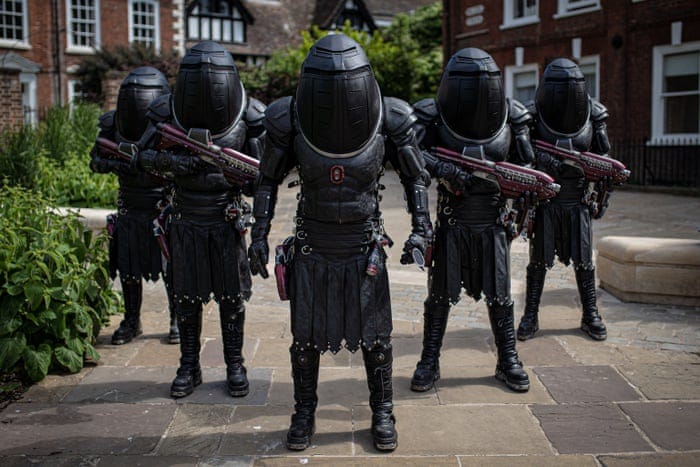
2. The Pinnacle?
Like the best Who stories, “Fugitive of the Judoon” begins with an everyday character unaware that unimaginable events will soon transpire around her. Patel and Chibnall take to heart former showrunner Russell T. Davies’s enthusiasm for depicting working-class characters as admirable people whose quotidian lives are as valuable as those of anyone higher up the social scale.
This love of so-called “commoners” is one of Classic Who’s and New Who’s greatest qualities. The fact that the program’s sympathies always lie with shop workers, bus drivers, school teachers, hospital nurses, garbage collectors, nightly custodians, warehouse technicians, and the millions of other regular folk who go about their daily lives without fuss or fanfare speaks to the series’s working-class ethos, as well as its love of puncturing the pomposity, arrogance, and cant of characters who think (wrongly) that they are better than everyone else.
At the center of “Fugitive of the Judoon” is Ruth Clayton (Jo Martin), a woman who gives guided tours of Gloucester Cathedral, one of the centerpieces of her small English town. As the morning of Ruth’s 44th birthday begins, she and her husband, Lee Clayton (Neil Stuke), affectionately spar over all the ways they will celebrate her happy day.
Patel, Chibnall, and director Nida Manzoor get straight down to business by focusing, right from the start, on small details that suggest larger goings-on: the first shot, for instance, sees the minute hand of Ruth’s watch ticking round as a piece of bread finishes toasting, while, later, Lee becomes worried after Ruth exits their flat. Sam Heasman’s & Catherine Goldschmidt’s fluid camerawork, alongside Rebecca Trotman’s crack editing, ensures that these particulars remain visible, yet unobtrusive. Ruth’s daily routine—she seems a genuinely happy person who greets the world with the warmth of a woman secure in herself and her lot in life—is both normal and menacing.
Ruth’s birthday celebration takes a drastic turn, however, when the Judoon beam a fugitive-recovery team onto the cathedral’s grounds. As the Judoon stomp their way around Gloucester, scanning people to determine if they are extraterrestrials hiding in human skin, Ruth witnesses an older woman named Marcia (Judith Scott) bolt in terror after she first sees the Judoon’s rhino-like features, only to disintegrate when she (Marcia) collides with a forcefield the Judoon have placed around Gloucester’s city center. When the TARDIS detects the Judoon’s presence on Earth, the Doctor does what she does best: plunge haphazardly into the situation, surviving via wit, guile, and more than a little luck.
Team TARDIS quickly encounters Ruth, who takes them home to find the fretful Lee somehow familiar with the Judoon’s hunt. When the Doctor finds a hidden box housing a military medal not of Earth’s origin, Lee refuses to answer questions, but promises to cover the group’s escape (the Judoon, having followed Ruth, threaten to destroy the Claytons’ flat).
Fleeing before the Judoon countdown ends, the Doctor and Ruth head to Gloucester Cathedral while Lee faces off with Commander Gat (Ritu Arya), the Gallifreyan contractor who hired the Judoon to locate a former colleague that, years before, betrayed Gat and the mysteriously named Division, the organization that employed all three. Gat unceremoniously executes Lee, whom she recognizes as her old co-worker’s associate, in a development that transforms “Fugitive of the Judoon” from fun, frothy adventure into lethal, actual tragedy.
And where, pray tell, are the companions? Ryan, Yaz, and Graham find themselves transported to an alien spacecraft piloted by none other than Captain Jack Harkness (John Barrowman), confidante of the Ninth and Tenth Doctors (Christopher Eccleston and David Tennant, respectively), immortal cosmic ne’er-do-well, lead character of the New Who spinoff series Torchwood (2006-2011), and, in “Fugitive of the Judoon,” ship thief. Yes, Jack has stolen the vessel to which he mistakenly transports Ryan, Yaz, and Graham while trying to find the Doctor.
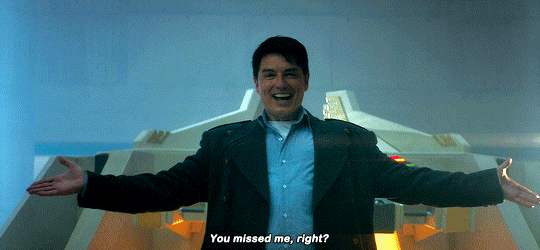
I smiled from ear to ear upon first hearing Barrowman’s voice issue from this ship’s intercom, then came whooping off my couch when Jack materializes before the befuddled Graham, who receives a patented Jack Harkness kiss-on-the-lips. Barrowman’s enthusiasm here stands in stark contrast to the last time we saw his character onscreen, all the way back in Torchwood’s 2011 episode “The Blood Line,” that program’s fourth-season finale (and, unless matters change, also its broadcast finale), which ended on a cliffhanger that saw Jack both amazed and perplexed by the resurrection of one of his Torchwood team’s dead members.
Jack, thanks to Big Finish Productions’ audio dramas (which include Torchwood’s official fifth and sixth seasons), has experienced many later adventures, but the fact remains that Whovians were forced to wait nearly nine years to see him again on television. Barrowman, I’m happy to say, does not disappoint: he looks terrific, plays Jack with the same fizzling exuberance we’ve come to expect, and, upon learning from Graham that the Doctor is now a woman, beams so brightly when he says “This I gotta see” that you can actually hear each word grin.
As New Who and Torchwood fans know all too well, Jack’s happy demeanor hides dastardly secrets, memories, and lies accrued during his immortally long life, and some of that darkness creeps its way into his too-short appearance in “Fugitive of the Judoon.” Jack, just before sending Ryan, Yaz, and Graham back to Gloucester, asks them to give the Doctor an ominous message: “Beware the lone Cyberman. . . . Tell the Doctor. . . the lone Cyberman. . . don’t give it what it wants. At all costs. Tell her!”
That Jack never meets the Thirteenth Doctor may seem like a dramatic cheat on Vinay Patel’s and Chris Chibnall’s part, but this oversight—apart from setting up a plotline that will come to fruition in Series 12’s two-part finale—is quickly forgotten when Ruth, who retreats to Gloucester Cathedral with the Doctor, begins having memory flashes of her old home in a lighthouse on the coast. When the Judoon intercept them, Ruth reflexively attacks their commander and, most surprising of all, speaks the Judoon language. The astonished Doctor can only tell Ruth, “I think there’s another identity hidden within you” as explanation, a sleeper personality activated by a text message sent by Lee just before his death: “Follow the light. Break the glass.”
What else to do but travel to that lighthouse? During the drive there, the Doctor tests Ruth’s memories of her own life, but nothing prepares them for the discoveries they make upon arrival, unanticipated revelations that the viewer—or, at least, this viewer—never sees coming.
Patel and Chibnall, you see, have ample tricks up their narrative sleeves. Jack Harkness’s return isn’t meant merely to delight longtime fans, but to keep us from anticipating that Ruth is, in fact, a Time Lord masquerading as human. The Doctor’s sonic screwdriver senses an object buried near the lighthouse, marked by an empty gravestone, so she investigates, leaving Ruth—who now hears voices whispering “Break the glass and follow the light” inside her mind—to locate a fire alarm inside the lighthouse bearing the inscription “Break glass.”
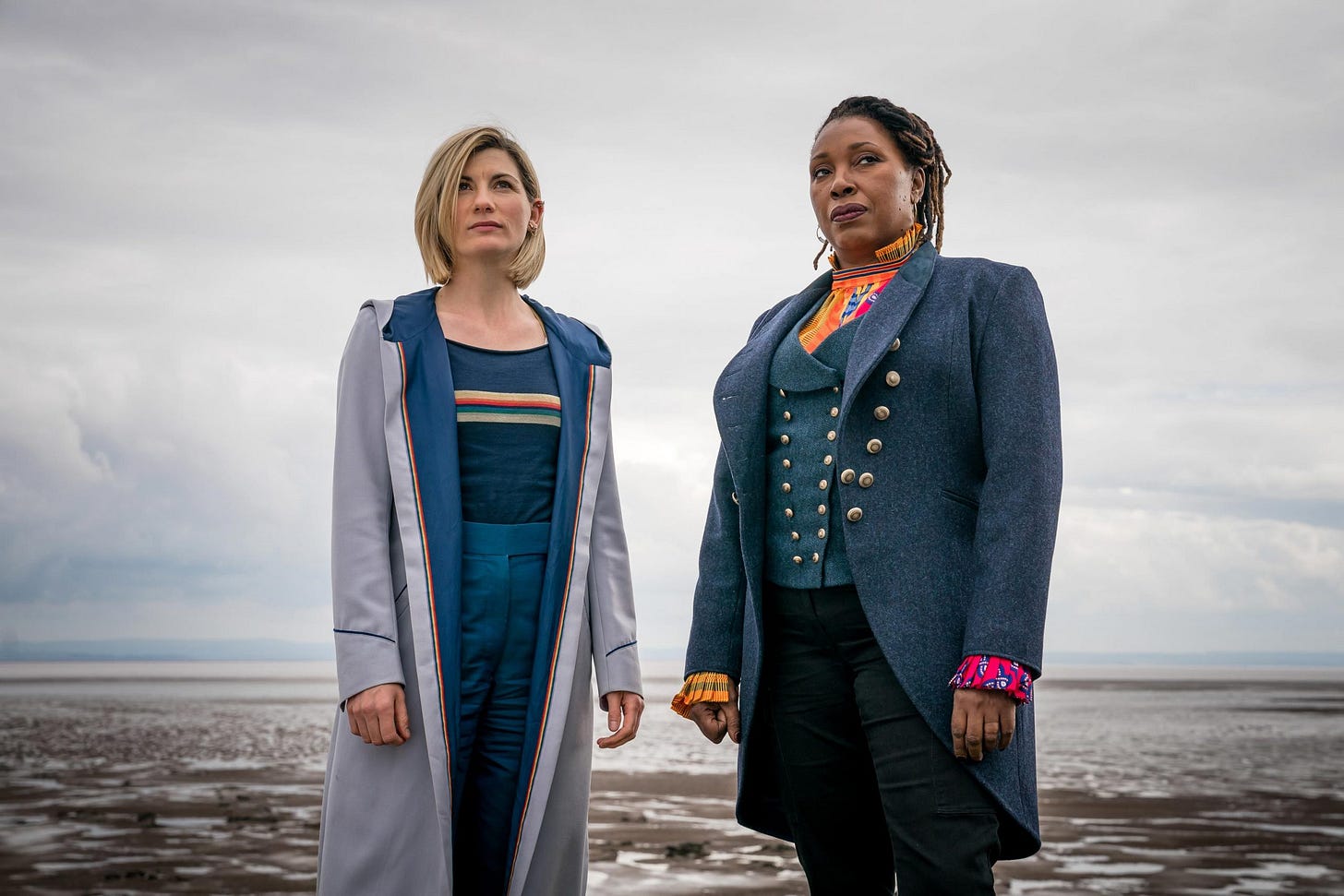
3. The Peak!
When Ruth does, golden energy rushes from the alarm into her head. Viewers like myself, who’ve been with Doctor Who since the beginning, scream “Chameleon Arch!” at this moment.
Yes, dear reader, Patel and Chibnall reach all the way back to Series 3’s exceptional, Paul Cornell-authored two-parter “Human Nature” / “The Family of Blood” to reference this Time Lord invention, a device capable of rewriting a Gallifreyan’s molecular biology, memories, and personality to transform said Time Lord into an entirely new person. Tennant’s Tenth Doctor undergoes this painful process in “Human Nature” to hide himself from the so-called Family of Blood, extraterrestrial predators who hunt him in hopes of stealing his ability to regenerate and his TARDIS’s technology.
This welcome reminder of one of New Who’s most brilliant achievements isn’t, however, mere nostalgia-dipping on Patel’s and Chibnall’s parts. No, they stamp the narrative accelerator when Ruth finds a large laser-gun in a nearby chest and a new set of clothes in a nearby closet, then go for broke when the Thirteenth Doctor makes the most shocking discovery (so far) of Series 12’s run. While digging in the nearby gravesite’s ground, the Doctor uncovers a blue police box crowned by a familiar lamp.
What?, you spit.
It can’t be!, you sputter.
Describing the sensation this recognition provokes—hackles rising, skin tingling, mind whirling in wonder—may be impossible, but the gobsmacking possibilities that the Thirteenth Doctor has uncovered her own TARDIS and that, in meeting Ruth Clayton, Thirteen has also encountered an unknown iteration of herself are almost too much to comprehend.
Ruth, resplendent in a beautifully checkered, Kente-cloth shirt and hoisting that enormous gun across her body, confirms this insane suspicion by uttering these immortal words: “Let me take it from the top. Hello, I’m the Doctor. I’m a traveller in space and time, and that thing buried down there is called a TARDIS: Time and Relative Dimension in Space. You’re gonna love this.”
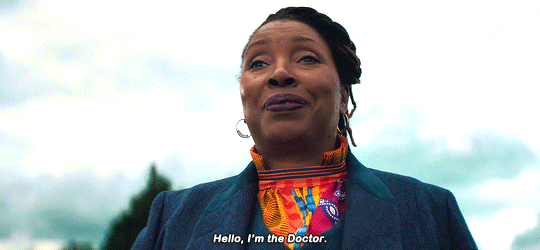
Crash! Wham! Bang! These sound effects aren’t heard onscreen, but inside the heads of every audience member (and the doubters among us should consult the dozen or more YouTube reaction videos to this moment for confirmation). Patel and Chibnall don’t tarry or leave us in shock, wonder, incredulity, and uncertainty for long, even if Jodie Whittaker’s wordless response is worth pausing to scrutinize. Whittaker’s face expresses all those emotions, and perhaps a dozen more, in the span of just four or five seconds, which cements her claim to every television-acting award there is.
Then this new Ruth Doctor (or Fugitive Doctor) transports the Thirteenth Doctor into her TARDIS, whose set design recalls Classic Who’s original timeship: you know, the one piloted by the First Doctor (William Hartnell in Classic Who and David Bradley in New Who), even if the Fugitive Doctor’s dialogue suggests she may be an even-earlier incarnation of our favorite Time Lord. The Fugitive Doctor, it seems, was dragooned into Division, which she describes as a temporal covert-operations agency that doesn’t take kindly to its captive workers trying to leave. The Fugitive Doctor, in fact, describes her time with Division as forced employment: “Not one [a job] you apply for, and not one you can leave. Believe me, I tried.”
Patel and Chibnall here set in motion a mammoth mystery about the Doctor’s past and future. Both the Thirteenth and Fugitive Doctors realize that neither one remembers the other, meaning that they cannot be the same person at different points in the same lifetime. And yet, when Thirteen’s sonic screwdriver confirms that their genetic codes precisely match, both women recognize that they are, somehow, the same person despite this possibility’s rank impossibility.
Keeping up? If not, fret not, since “Fugitive of the Judoon” keeps topping itself. The Fugitive Doctor’s entrance and existence are so dazzlingly handled that viewers (or, again and at least, this viewer) are left breathless. Jo Martin is simply magnificent as both Ruth Clayton and the Fugitive Doctor, especially when she scoffs at the Thirteenth Doctor’s dress and behavior in moments that recall the War Doctor’s (John Hurt’s) amazement, in “The Day of the Doctor,” when he cannot quite believe that the Tenth (Tennant) and Eleventh (Matt Smith) Doctors are future incarnations of himself.
Audience members hoping that “Fugitive of the Judoon” will resolve the questions it raises about the Fugitive Doctor’s identity—is she an earlier, later, or alternate version of the Thirteenth Doctor?—don’t know Chris Chibnall or Doctor Who terribly well.
John Hurt’s memorable War Doctor gives Chibnall license to introduce the possibility—more than that, the seeming reality—of a forgotten version of the program’s titular protagonist emerging at a crucial time, while Jo Martin’s beautiful performance grounds this new character in the episode’s madcap events as superbly as Hurt’s impressive portrayal of the War Doctor grounds his character in the Fiftieth Anniversary Special’s franchise-shaking developments.
Suffice to say, the Thirteenth Doctor and the Fugitive Doctor combine their efforts to outwit Commander Gat and her Judoon mercenaries, even if the Fugitive Doctor’s fatal trickery (of Gat, who runs afoul of that huge laser-gun) upsets Thirteen’s moral sensibilities. Once the Thirteenth Doctor reunites with her three companions on her own TARDIS, the episode’s scant remaining moments don’t give us long to ponder what’s just happened.
No, that task falls to later installments, particularly Series 12’s two-part finale, but, for now, “Fugitive of the Judoon” does its job admirably: holding viewers in its relentless narrative grip, launching a thousand fan rumors (about the Fugitive Doctor’s identity), and demonstrating that many criticisms about the Chibnall era’s writing have always been unfair.
As such, “Fugitive of the Judoon” is a fabulous hour of Doctor Who, proving once again that, even fifteen years after the program’s 2005 regeneration, it remains a terrific example of its medium. So, cheers and cheers and cheers to everyone involved, because I, for one, can’t wait to see what happens next.




